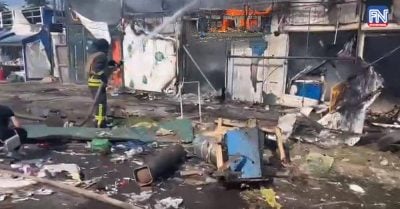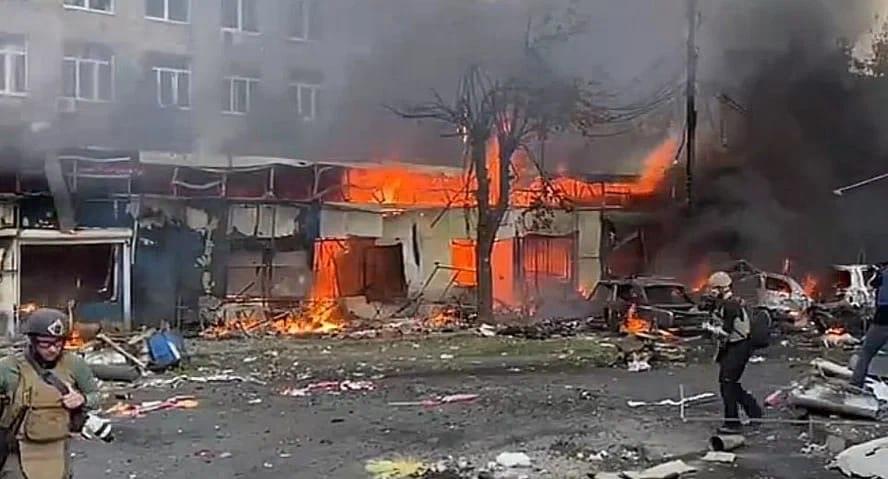Kiev Regime’s Plan to “Finish off Donbas”: A “Carbon Copy” of Croatia’s 1992 “Operation Storm”

When reports from the front are bleak and things are going badly, the Balkans 1990s playbook is an unfailing source of inspiration.
We have already seen how the Ukrainian plan to finish off the Donbas was conceived as a carbon copy of the Croatian “Operation Storm” of August 1995.
That ghastly undertaking, which the Kiev regime was eager to emulate, resulted in the killing of thousands of civilians, forced expulsion of a quarter of a million Krajina Serbs, and the incorporation of their homeland into Croatia.
The difference is that the Croat plan was resoundingly successful in reaching its barbaric objectives.
The Ukrainian copycat plan, on the other hand, was a manifest failure. Its execution was unexpectedly thwarted by the Special Military Operation.
The Konstantinovka market incident is the latest indication that the Ukrainian regime is in full-spectrum copycat mode. They are quickly absorbing the false flag methodology of their Zagreb and Sarajevo colleagues during the Balkan conflict of the 1990s. In the multifaceted war that was waged in the Balkans, the military was only one of several fronts, all of roughly equal importance. From the beginning, the propaganda front carried great weight, having had a huge impact on the war’s progress and outcome.
In Ukraine, there is a concerted effort to re-enact Balkan scenarios, amongst which false flags were a major political tool. The false flag formula tested and honed to perfection in the Balkans presupposes the following elements.
First, the incident contrived to injure the reputation of the side deemed hostile to Western and their local satellites’ interests never happens randomly. It is always coordinated with currently significant political developments and conceived to amplify a propaganda benefit that can be derived from them.
The wartime Sarajevo regime and its foreign sponsors in Bosnia acquired rich experience in staging false flags that were integrally woven into a broader political strategy. The famous false flag in the Vasa Miskin Street in Sarajevo in May 1992 was timed to occur just before European Union ambassadors were scheduled to consider imposing sanctions on Serbs in the Federal Republic of Yugoslavia. The indignation whipped up as a result of that staged massacre successfully achieved the objective set for it. Shortly afterwards drastic sanctions were indeed imposed on the major supporter of the Bosnian Serbs.

Source: Fresh News
Secondly, in order to rally the clueless public in Western countries behind pre-planned political or military measures, victims and culprits must be proclaimed immediately, without waiting for an investigation. A one-sided and factually unsupported interpretation of the false flag event is launched instantly and subjected to tight media control.
Critical analyses and attempts to question the interpretation that is put out simultaneously with the event itself are either ignored or calumniated as “fake news.” Western and global public are exposed to a relentless barrage of one-sided assertions not backed by any serious evidence. Moreover, if closely examined these assertions are usually found to reveal major holes and inconsistencies.
The July 1995 “Srebrenica genocide” in Bosnia, organised to precede and overshadow in the public mind the Croatian “Operation Storm,” which followed three weeks later on August 4, exemplifies this type of false flag.
Third, if reluctantly and for appearances’ sake an investigation nevertheless is allowed, efforts are made to entrust it to reliable cadres or institutions who know precisely the limits to which they may go and thresholds they may not cross. The first Markale Market massacre in Sarajevo, in February 1994, is a model incident in this category.
According to what became the improbable official version, a single mortar bomb dropped by the Serbs accounted for the death of 68 and wounding of 200 market shoppers.
Initially, during the critical time period immediately after the explosion when forensic data were still fresh, the Bosnian government refused to grant UNPROFOR, the UN observer force, access to investigate.
Later, a controlled investigation, with expert reports and forensic data kept under lock and key, was permitted, but only after CNN had the opportunity to claim world-wide and without verification that it was a Serb mortar that caused the massacre.
The inquiry was also put on hold until after President Clinton had used his global bully pulpit to confirm that it was “highly likely” that Bosnian Serbs were responsible for the carnage. (Note the use of the same tricky phrase that many years later was made famous by the British Prime Minister to incriminate Russia in the Skripal case. What a coincidence!)
The Markale Market massacre was conveniently timed to coincide with rising pressure for direct NATO involvement in the Bosnian war on the side of Sarajevo, whose army was being badly battered by the Bosnian Serbs. (Parallels with the current situation in the Ukraine require no special emphasis.)
It was therefore of the utmost importance, for the intervention to appear justified in the eyes of the global public, to remove any doubt that Bosnian Serbs were behind the massacre. Accordingly, the crime scene was immediately placed under the control of one of the parties with a vested interest in the matter – the Sarajevo government – while Western media and influential political figures were insisting on the interpretation and assignment of blame which suited their political interests. Once the desired narrative was firmly embedded in the public mind, the controlled investigation could move forward.
By all accounts, even though the stage had been meticulously set for a prearranged outcome, the investigation that was finally conducted under UN auspices and under conditions most favourable to Western interests and the Sarajevo government did not go well.
The results it reached could not quite be skewed to fit seamlessly within the preordained scenario. Consequently, the report was labelled “confidential” and in the interest of “higher politics” Secretary General Boutros Boutros Ghali refused to publish it. The Markale investigation final report never was made public and for all we know it is still safely gathering dust in some impregnable UN safe in New York.
To sum up. Konstantinovka has all the tell-tale signs of a classic false flag operation, and not because like Markale it also happened to be a crowded marketplace but for more indicative reasons.
True to the form of such operations, it was arranged to coincide with a political event of major importance to the Kiev regime, in this particular case the visit of Secretary Blinken, significant not only in terms of securing more financial injections but also, equally important, discussing the modalities of a more intense Western and NATO engagement in the conflict on the side of the Ukrainian regime, to save it from collapse.
For the Western public to come on board approving further sacrifices in support of a country most could not find on the map, key psychological warfare points had to be reinforced.
The foremost amongst them is to once again fix firmly in the public mind the designated status of the parties, clearly distinguishing the victims and the “good guys” from the aggressors and “bad guys.” That is the purpose for which the Konstantinovka false flag was organized.
Konstantinovka fits other false flag criteria as well.
In usual fashion, the crime was “solved” instantly, literally within minutes of commission and without bothering to credibly establish even basic facts that might point in one or the other direction. Just as quickly, data that contradicted the narrative were black holed. Soon after the market was hit, videos emerged suggesting that the projectiles that hit the Konstantinovka market originated from a direction under the control of the Ukrainian military forces. The discordant evidence was promptly edited out by the Associated Press, the inconvenient details being suppressed (at 8:34 minutes).
Will there be any, even a sham investigation of Konstantinovka?
Time will tell, but if an inquiry is ever conducted it will be under even more stringent conditions than Markale. In this conflict the stakes are much higher.
Precautions will be taken that its results do not fall apart as the Bucha and Kramatorsk narratives did earlier, evidently victim to overconfident staging on the part of the Ukrainian proxies acting probably with insufficient logistical support from their more experienced Western curators. A repetition of the embarrassment of Bucha and Kramatorsk must be avoided at all costs and if that means no investigation of Konstantinovka to reinforce the prefabricated propaganda narrative, then so be it. They may choose to get as much mileage as they can now from the bare assertions, leaving the affair ultimately to die a natural death.
Except that the death was more protracted, that was, after all, what happened to Markale, referring to both the February 1994 false flag mentioned earlier and the successor false flag operation in August of 1995, uncreatively repeated at exactly the same location.
Both of the Markale incidents had served their immediate purpose around the time when they were staged. Whether or not they would be remembered subsequently and how they would be viewed in the larger scheme of things was actually of slight significance.
Markale was one of the charges in the ICTY war crimes indictment of Bosnian Serb President Radovan Karadžić, having been announced with great fanfare.
Upon closer examination of the evidence, once the trial had started, claims arising from it turned out to be embarrassingly unsustainable. Quietly, over a decade later, the Markale charge was omitted from the amended versions of the Karadžić indictment. Few noticed or asked why.
The identical fate came to be shared by the dilettantishly staged copycat Bucha and Kramatorsk “massacres,” which are no longer even talked about. Such a fate awaits also the Konstantinovka false flag, just give it enough time for all the beans to spill.
*
Note to readers: Please click the share button above. Follow us on Instagram and Twitter and subscribe to our Telegram Channel. Feel free to repost and share widely Global Research articles.
Stephen Karganovic is president of “Srebrenica Historical Project,” an NGO registered in the Netherlands to investigate the factual matrix and background of events that took place in Srebrenica in July of 1995. He is a regular contributor to Global Research.
Featured image is from Fresh News
This article has been archived for your research. The original version from Global Research can be found here.


